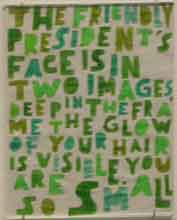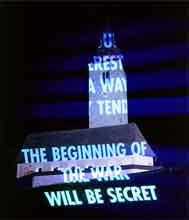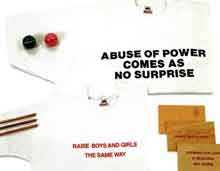Apart from the crowded conditions and the fact that I couldn’t see the slides and the fact that it went on way too long I really enjoyed Jenny Holzer‘s talk at ICA the other night. See Libby’s post for more and pardon some redundancy here.

What struck me was how the artist uses the second person “you” in some of her writings and by you she means me, not herself. Her voice is imperative. (image is a holzer imperative)
It made me think of Anthony Campusano‘s word art at Levy Gallery at Moore and his use of “you” When he says “you” as in the piece “Everything I learned I learned Twice” at Levy Gallery at Moore College or his “Self Portrait with the 39th President (Second Person).” For Campusano “you” is him. He’s talking with himself, so when he writes “You are five years old and the street fills with people..” he’s telling an anecdote about himself to himself.
Maybe that’s the difference between public art (Holzer’s) which has a kind of engagement or dialog with the exterior world and work that is more private in its origins. All public art is exclamatory and what it exclaims is usually imperative — from statues of heroes which say “Honor them!” to Holzer’s command to “Mind your own business.”
That made me wonder whether Campusano’s work couldn’t engage with a big audience, too, in the way that music, Dylan ballads, for example, do. Music’s use of “you” is often personal and imperative.

And as with music, Campusano’s work relies on empathy to translate the personal into something much more broad. When at the end of the “Self Portrait” piece the artist describes looking at a photograph with the president and himself and other people in it and ends on this note: “You are so small,” He’s translated the story into something we can all identify with — feeling inadequate in the face of life’s big hurly burly. (image is detail of Campusano’s “Self-Portrait with 39th President, (Second Person))
At a time when — ironically — personal reflection is at an all time low and personal confession is at an all time high it seems that a dose of Campusano’s art in the public sphere is called for. I’d love to think of it out there on a building, a reminder of how we are in essence all alike and small and how our inner reflections are precious if we ever allow ourselves the time to reflect.
Getting back to Holzer:
The best thing about the lecture for me was to hear how the artist’s words spilled out of her sounding every bit like the words she writes — pithy, ponderous and epigramatic. Even her voice sounds like her words, not high pitched, but a rich contralto.
About her roots as a painter, in the 1970s, she said: “I had been an extremely poor abstract painter. I arrived at the Whitney Studies Program and that program began to redeem me.”
The program made her a reader of tomes. And out of that experience she distilled what she’d learned into her “truisms,” the one-line wonders that are her trademark and have flashed across Times Square light boards, Las Vegas baggage claim check areas and the Candlestick Park Jumbotron.
About grafitti artist Lady Pink, with whom she collaborated a number of times, she said “She does great women. Major babes. I contribute the text.”
About showing in a gallery, DIA, she said “I was confident on posters and in Times Square but less secure on art in blank spaces. First I turned off the lights. That made me feel secure.”

About showing at the Guggenheim, where she wrapped her messages around the spiral: “It’s a building that snuffs art…I decided to go with Wright rather than have him erase them [them words].” (image is detail from Guggenheim installation)

About what she called her new occupation, outdoor projections at night on the sides of buildings, (like the one above which was in Berlin) she said:
About a Mies Van Der Rohe building in Berlin “It doesn’t need art — it’s perfectly glorious and self sufficient.”
About her projections reflected on water at night “Water is very kind to projections.”
Projections are what she aimed for in painting, she said — “a loveliness and atmosphere.”
In answer to a question about how she likes working on public art she said “The process is often as interesting as the art making.”
About watering down her work to suit a public client: “I don’t do a piece if it’s going to be made pale by subtraction.”
About using text by people other than herself now instead of using her own words she said “Because I’m sick of writing and not capable of it I went to a poet.”
About her themes she said:
“War comes back time and time again. Courtesy of the world it’s there again.”
“I’m always interested in what’s not spoken about but should be.”
About using new technology like cellphones to get her art out there:
“I like to put text where people are looking (cellphones).”
About her education:
“I didn’t have much of an art education and that served me well. I had more of a liberal arts education than an arts education. Eventually I went to RISD.”

About the legality of projecting on buildings: She’s always gotten permission but “There’s no law against it.”
Finally, here’s Libby’s 2004 post about Holzer’s art on some benches lining a walkway at Penn. Do we like it any better now? I’ve never seen it but that’s an oversight. I guess I’ll need to get over there and think about those words on those benches. By the way, she said that she’s always looking to put more benches in the world. I’ll second that as a mission. Oh and also, she said she’s always been in favor of cheap art, which should be no surprise for someone who gives it away in the streets of the world. So to see her truisms on t-shirts and golf balls, as in the bottom two images, should come as no surprise. You can get this merch at the MOMA website or store.










